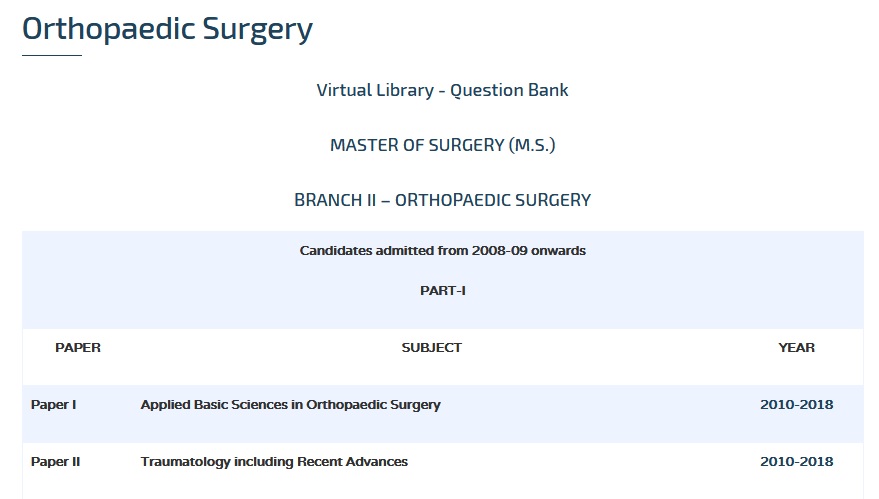Traumatology Including Recent Advances MS Question Bank : web.tnmgrmu.ac.in
Name of the University : The Tamilnadu Dr. M.G.R. Medical University
Degree : M.S.
Branch : Branch II – ORTHOPAEDIC SURGERY
Subject Code/Name : 2237/Traumatology Including Recent Advances
Paper : II
Document Type : Question Bank
Website : web.tnmgrmu.ac.in
Download Model/Sample Question Paper :
2010-2014 : https://www.pdfquestion.in/uploads/web.tnmgrmu.ac.in/4367-222237KX.pdf
TNMGRMU Traumatology Recent Advances Question Paper
Sub. Code: 2237
M.S. DEGREE EXAMINATION
Branch II – ORTHOPAEDIC SURGERY
Paper II – (for candidates admitted from 2004-05 to 2007-08)
Part II –Paper I –(for candidates admitted from 2008-09 onwards)
TRAUMATOLOGY INCLUDING RECENT ADVANCES
Q.P. Code : 222237
Time : Three hours
Maximum : 100 marks
Related : TNMGRMU Applied Basic Sciences in Orthopaedic Surgery MS Question Bank : www.pdfquestion.in/4361.html
March 2010
Answer ALL questions :
Draw suitable diagram wherever necessary :
I. Essay questions : (2 x 20 = 40)
1. Classify calcaneal fractures. How will you investigate and manage communited. Intra articular fracture calcaneum in a young adult?
2. Classify epiphyseal injuries. Enumerate the complications of epiphyseal injuries and discuss their diagnosis and management.

II. Write short notes on : (10 x 6 = 60)
1. Tension band wiring.
2. Proximal femoral nail.
3. Trans cutaneous electrical nerve stimulation. (TENS)
4. Kaplan’s dislocation.
5. Minimally invasive plate osteosynthesis (MIPO).
6. Crush syndrome.
7. Mid carpal instability.
8. Central fracture dislocation of hip.
9. Lag screw principle.
10. Skeletal traction.
March 2009
Sub. Code: 2237
I. Essay questions : (2 X 20 = 40)
1. Describe clinical features, assessment and management of distal femoral fractures in an osteoporotic patient.
2. Classify fracture neck of femur in children. Discuss its management and complications.
II. Write short notes on : (10 X 6 = 60)
1. Subluxatio erecta.
2. Limited contact dynamic compression plate.
3. Fracture of lateral humeral condyle.
4. Titanium elastic nail.
5. Crush syndrome.
6. Acromio clavicular dislocation.
7. Fracture neck of talus.
8. Medial meniscal injuries.
9. Fat embolism.
10. Green stick fracture.
September 2010
I. Elaborate on :
1. Describe etiopathology, classification, clinical features and management of Tibial condyle fracture.
2. Classify Calcaneal fractures. Discuss its management and complications.
II. Write notes on :
1. Anterior shoulder dislocation.
2. Cable – Plate System.
3. Monteggia fracture dislocation.
4. Volar Barton’s fracture.
5. Buttress Plate.
6. Medoff sliding plate.
7. SLAC (Scapho Lunate Advanced Collapse).
8. DISI (Dorsal Intercalary Segment Instability).
9. Lumbar disc replacement.
10. TLIF.
October 2011
Answer ALL questions in the same order. :
I. Elaborate on :
1. Classify supracondylar fractures of humerus in children. Discuss the complications of supracondylar fracture and management of cubitus varus deformity.
2. Classify lower cervical spine fractures. Discuss the management of unilateral fracture dislocation of C5 over C6 with incomplete deficit.
II. Write notes on :
1. Intercarpal instability.
2. Locked compression plate.
3. Fractures at the upper end of humerus.
4. Rotator cuff injury.
5. Tension band principle.
6. Pilon fracture.
7. Physeal injuries.
8. Operative complications of acetabular fractures.
9. Classify posterior dislocation of hip.
10. Complications of posterior dislocations of hip.
April 2012
I. Elaborate on : Pages Time Marks
1. Classify Trochanteric fracture and discuss the management of 16 35 15 unstable trochanteric fracture.
2. Classification of fracture neck of Humerus and its management. 16 35 15
II. Write notes on :
1. Describe the etiology, clinical features and management of Posterior dislocation shoulder. 4 10 7
2. Write about the classification of Nerve injury and add a note on the management of Neurotemesis. 4 10 7
3. Classify Fracture talus and discuss the management. 4 10 7
4. Discuss the management of a patient with Trimalleolar Fracture. 4 10 7
5. Describe the anatomy of Posterior cruciate ligament and mention the clinical features and management of Posterior cruciate ligament injury. 4 10 7
6. Discuss the Classification fracture head of femur and Management. 4 10 7
7. Write a note on Whiplash injury. 4 10 7
8. Write short notes on Volar intercalated segmental instability. 4 10 7
9. Discuss clinical features diagnosis and management of Compartment syndrome. 4 10 7
10. Neglected Monteggia lesion. 4 10 7
October 2012
Answer ALL questions in the same order.
I. Elaborate on : Pages Time Marks
1. Describe the mechanism, clinical features and management of traumatic dislocations of hip in adults. 16 35 15
2. Write on mechanism, classification and management of proximal humerus fractures. 16 35 15
II. Write notes on
1. Principles of biological plating. 4 10 7
2. Etiology and management of algodystrophy. 4 10 7
3. Clinical signs and investigations of fat embolism. 4 10 7
4. Medial condyle fracture of humerus- Classification and Post operative protocol. 4 10 7
5. Displacements in Smith fracture and its surgical management 4 10 7
6. Classification and radiological evaluation of Jefferson fractures 4 10 7
7. Mangled Extremity Severity Score. 4 10 7
8. Proximal Femoral Nail- Indication and complications. 4 10 7
9. Principles of Distraction osteogenesis. 4 10 7
10. Ogden’s classification of epiphyseal injury. 4 10 7